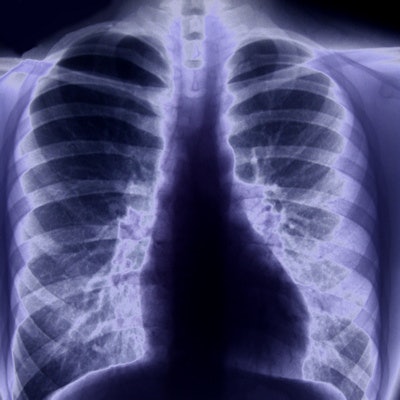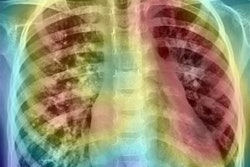
A computer-aided detection (CAD) software application based on artificial intelligence (AI) is able to identify pulmonary nodules quickly and accurately on chest x-rays, offering potential to serve as a triage or second-reading tool for radiologists, according to research published online September 11 in Clinical Radiology.
After retrospectively evaluating a commercial deep learning-based software application on 100 patients, a team of researchers led by C.H. Liang of National Yang-Ming University in Taipei, Taiwan, found that it yielded an area under the curve (AUC) of up to 0.916. What's more, the software processed the radiographs in less than two minutes.
"[The software] could be used to automatically evaluate all chest radiographs efficiently. ... Implementation of deep learning with different algorithms could help radiologists improve medical imaging care," the group wrote.
The researchers sought to evaluate the diagnostic performance of Chest X-ray Classifier, which was created by Spanish software developer QUIBIM. First, they gathered a dataset of 100 patients from Kaohsiung Veterans General Hospital in Kaohsiung, Taiwan. Of these 100 patients, 47 had clinically significant pulmonary nodules or masses and 53 were control subjects without pulmonary nodules. Chest radiographs with posteroanterior view were used in the study, and radiographic findings were validated by a CT exam.
Chest X-ray Classifier features four different deep-learning algorithms:
- A heat map algorithm that aims to highlight the most abnormal region on the x-ray
- A nodule probability algorithm
- A mass probability algorithm
- An abnormal probability algorithm
The researchers separately calculated the performance of each of the four algorithms for identifying pulmonary nodules. The mass probability algorithm yielded the best overall performance.
| Chest X-ray Classifier performance for detecting pulmonary nodules on chest radiographs | |||||
| Heat map algorithm | Abnormal probability algorithm | Nodule probability algorithm | Mass probability algorithm | ||
| Sensitivity | 38.3% | 74.5% | 85.1% | 76.6% | |
| Specificity | 98.1% | 81.1% | 64.2% | 88.7% | |
| Area under the curve | 0.682 | 0.810 | 0.813 | 0.916 | |
In addition, the software had a mean image processing time of 94.07 ± 16.54 seconds per case.
The researchers noted that each of the algorithms offered different benefits. For example, the heat map algorithm had the highest specificity. By implementing different deep-learning algorithms via the Chest X-ray Classifier, radiologists could reduce errors with selective double reading, according to Liang and colleagues.
"Using these different algorithms strategies, the deep-learning algorithm could potentially assist radiologists in detecting pulmonary nodules on chest radiographs while minimizing both false positives and false negatives," they wrote. "These algorithms could support radiology workflow by flagging suspicious cases prioritized on the radiology worklist so that they can be reviewed first."
An alert based on an early warning score could be integrated into the reporting system to streamline workflow, according to the researchers. Radiologists could then pay more attention to radiographs with a higher probability score, while confidently excluding lesions on chest films with a lower probability score.
"In conclusion, deep learning-based CAD systems will likely play a vital role in the early detection and diagnosis of pulmonary nodules/masses on chest radiographs," the authors wrote. "In future applications, these algorithms could support triage workflow with double reading to improve sensitivity and specificity during the diagnostic process."




















